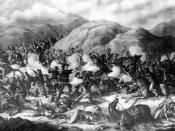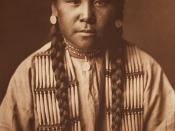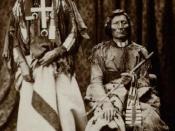Cheyenne Indians, an important Plains tribe, speaking a language belonging to the Algonkian family. Their name is derived from the Sioux Indian word that means "people of alien speech."
In 1804 the explorers Lewis and Clark met the Cheyenne tribe near the Black Hills of South Dakota, but there is evidence that before 1700 the Cheyenne had lived a more settled existence in Minnesota. By the mid-1800's the Cheyenne had become fully adapted to a nomadic way of life based on the hunting of big game, primarily bison and antelope. Fish, small game, and wild vegetable foods supplemented their diet. The Cheyenne lived in skin tepees and used skin clothing.
In the nomadic period, the Cheyenne engaged in almost continuous warfare with neighboring tribes and, after 1860, with the white men. Camps of friendly Cheyenne were attacked by U.S. Army troops at Ash Hollow and Sand Creek, and their women and children were slaughtered.
In 1876 the Northern Cheyenne helped defeat Custer's force at Little Bighorn. Later, however, they met military reverses and ceased fighting after destruction of the camps of chiefs Dull Knife and Two Moons. After these defeats, the Northern Cheyenne were resettled in Indian Territory (now Oklahoma) along with the Southern Cheyenne, who had settled earlier in southern Colorado. Several attempts to leave Oklahoma failed; the last was in 1879, when 64 Indians were killed by troops and 78 recaptured. Later one reservation was established in Montana and another in Oklahoma.
The Cheyenne were organized into 10 main bands made up of family groups. These bands were led by a council of 45 peace chiefs, each a renowned warrior chosen for a 10-year term of office. Cutting across the bands were the military societies. Originally five in number, these increased to seven during the 19th...


